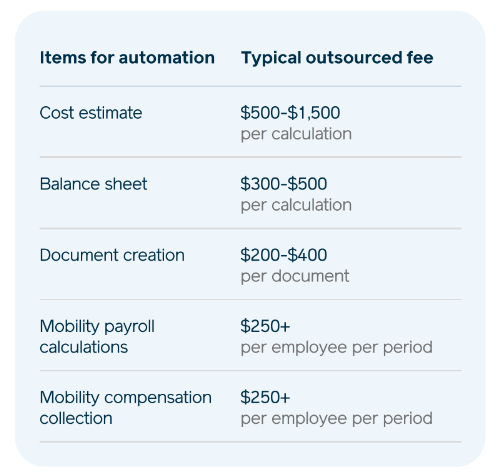Saving Time & Money: The Power of Automation in Your Global Mobility & Distributed Work Programs
Global mobility management has undergone a significant transformation in recent years, extending far beyond conventional expatriate programs. There has been a resurgence of long- and short-term assignments, accompanied by a growing employee preference for remote and hybrid work arrangements as well as the return of business travel. This combination of changes presents a challenge for global mobility and HR professionals, who must now manage workforces that are more distributed than ever with limited resources, fragmented technology, and an overwhelming number of manual processes.
Risks created by relying on manual processes
Many global mobility teams are heavily reliant on repetitive manual data entry. This time-consuming and tedious approach burdens mobility professionals with tasks such as logging into various isolated systems, manually creating documents and managing a multitude of emails and spreadsheets. This method is prone to human error and can open up a host of risks for an organization.
These include:
- Exposure to tax and immigration compliance risks
- Incurring high costs and wasting countless hours waiting for information like cost estimates from third-party vendors
- Fragmentation of data among multiple HR teams
- HR professionals experiencing burnout due to spending a substantial amount of their time on data entry
The need for automation
In this new era of highly distributed work, the global mobility team has a pivotal role to play in driving strategic change within organizations, enabling companies to become more agile and putting them in a better position to attract and retain top talent. This is particularly crucial in the current climate where the demand for work location flexibility among employees is at an all-time high. Our recent survey report, ‘Adapt to the new realities of your distributed workforce’ revealed that 9 in 10 employees say that they are either interested in an assignment abroad or have completed an assignment in the past. And 66% of employees believe that the chance to work in different locations internationally is critical to career growth and mobility, especially in senior roles.
This high demand for assignments among employees and increasing workforce mobility due to remote work poses challenges for organizations. Relying on manual processes in your global mobility program will hinder your ability to manage the new realities of increasingly distributed workforces in a compliant way. To address these issues, it is usually much more effective to automate key tasks using technology, saving you time and money in the process.
How much can you save by automating global mobility processes?
While global mobility teams relying on manual processes expose themselves to more risk, they also typically spend thousands of outsourced fees for calculations, which are often charged on a per-unit basis. By automating your mobility workflows, cost estimates and document creation tasks with technology, your organization can stand to save thousands by reducing or eliminating:
- Pay-per-calculation cost estimates
- Pay-per-calculation balance sheets
- Pay per document created
- Manual 3rd party expat payroll services
- Development and maintenance of custom in-house software
- Big-4 accounting firm service fees for gathering and cleaning data
Typical outsourced costs are as follows:
 The amount you stand to save through automation can be significant. The table below provides indicative levels of savings across reduced costs, increased efficiency and improved compliance.
The amount you stand to save through automation can be significant. The table below provides indicative levels of savings across reduced costs, increased efficiency and improved compliance.

Find out more
Relying on manual processes and spreadsheets in your global mobility program will hinder your ability to effectively manage distributed workforces while ensuring compliance. To address this challenge, it is necessary to automate key tasks using technology, which can not only reduce your exposure to risk but save you thousands in the process. To find out more, download our ebook, ‘Accelerate your global mobility and distributed work programs with technology’, here.

-1.png)
